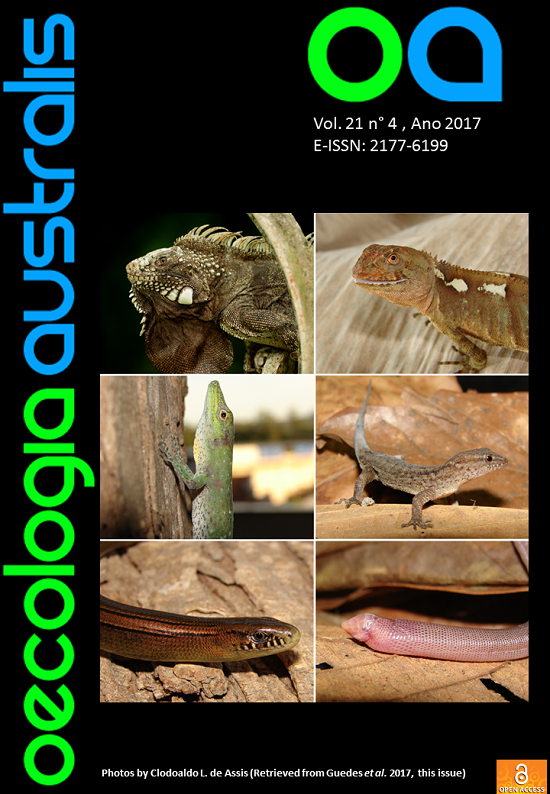ABELHAS E VESPAS (HYMENOPTERA) COMO INDICADORAS ECOLÓGICAS EM UMA ÁREA DE RESTAURAÇÃO FLORESTAL
DOI:
https://doi.org/10.4257/oeco.2017.2104.04Keywords:
assembly, colonization, disturbed habitat, ecological successionAbstract
A fim de investigar a resposta de abelhas e vespas (Hymenoptera) à restauração ambiental, foram comparadas assembleias de um fragmento em restauração a outros seis fragmentos de floresta primária no oeste do Paraná, Brasil. Abelhas e vespas foram amostradas em cinco fragmentos em 2013 e os restantes, incluindo o fragmento em restauração, em 2014. As amostragens foram realizadas por pratos-armadilha nas cores azul e amarelo, entre às 9:00h-15:00h, durante os meses de fevereiro, março e abril. O número de armadilhas variou conforme o perímetro das áreas para garantir uma amostragem proporcional. No total, foram realizadas 21 coletas, com esforço amostral de 126h. O fragmento em restauração apresentou valores de índices ecológicos estatisticamente iguais àqueles dos maiores fragmentos de floresta amostrados, porém com composição de espécies diferente destes. As principais espécies a diferenciar as assembleias dos fragmentos e da área em restauração foram identificadas pela análise SIMPER. Em geral as espécies comuns dos fragmentos de floresta apresentaram uma correlação significativa (rs < 0,05) com algum dos descritores de áreas testados. No entanto, não houve associação entre as principais espécies do fragmento restaurado e os descritores de área (rs > 0,05). O fragmento em restauração oferece oportunidade para uma colonização diversificada e com composição própria de abelhas e vespas, porém ainda diferente dos seis fragmentos referência e por isso ainda não considerado como restaurado.
ABSTRACT - BEES AND WASPS (HYMENOPTERA) AS ECOLOGICAL INDICATORS IN A FOREST RESTORATION AREA
In order to investigate the response of bees and wasps (Hymenoptera) to environmental restoration, one assemblage of a restoration fragment was compared to six other primary forest fragments in western Paraná, Brazil. Bees and wasps were sampled in five fragments in 2013 and the remainder, including the fragment undergoing restoration, in 2014. The samples were collected by bowl-traps in blue and yellow colors, between 9 am and 3 pm, during February, March and April. The number of traps varied with the perimeter of the areas to ensure a proportional sampling effort. In total, 21 samples were taken, with sampling effort of 126 h. The restoration fragment presented ecological indexes values (H', D and Dmn) statistically equal to those of the largest sampled forest fragments, but it has different species in relation to other forest fragments. The main species to differentiate the assemblages of the forest and restoration fragments were identified by SIMPER analysis. Generally, the common species of forest fragments showed a significant correlation (rs < 0.05) with area descriptors. However, there was no association between the main species of the restored fragment and the area descriptors (rs > 0.05). The fragment in restoration provides opportunity for a diverse colonization and presents its own composition of bees and wasps, but still different from the six reference fragments and so it is still not considered as restored.


